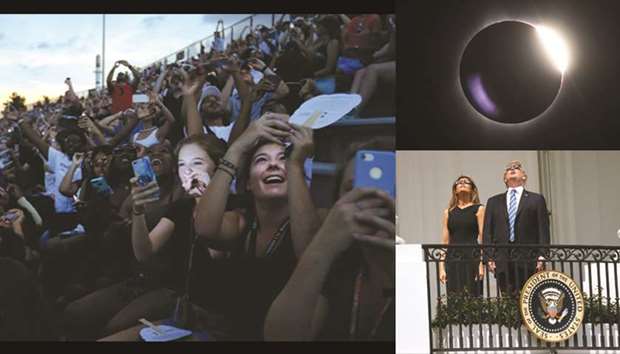The moon blacked out the sun yesterday as the first total solar eclipse in a century marched from the US Pacific Northwest to the Atlantic Coast, while millions of Americans looked skyward in wonder through protective glasses, telescopes and cameras.
After weeks of anticipation, onlookers experienced an astronomical phenomenon – two minutes in which the moon moved in front of the sun to create near darkness and cause a precipitous drop in temperature.
The eclipse drew whoops and cheers from onlookers in Depoe Bay, Oregon, near where “totality” – the shadow created by the sun’s disappearance – started.
“It just kind of tickled you all over – it was wonderful – and I wish I could do it again,” said Stormy Shreves, 57, a fish gutter who lives in Depoe Bay. “But I won’t see something like that ever again, so I’m really glad I took the day off work so I could experience it.”
The last time such a spectacle unfolded from one US coast to the other was in 1918.
The last total eclipse seen anywhere in the United States took place in 1979.
The rare cosmic event was expected to draw one of the largest audiences in human history, including those watching through broadcast and social media.
Some 12mn people live in the 70-mile-wide (113km-wide), 2,500-mile-long (4,000km long) zone where the total eclipse was to appear, while hordes of others travelled to spots along the route.
“It was incredible,” said Cheryl Laroche, 57, who with her husband, Rob, joined other observers at Roshambo ArtFarm in Sheridan, Oregon. “It was literally cold and dark. The light was blue.”
The eclipse first reached totality in Oregon at 10.15am PDT (1715 GMT) and began moving eastward across the country.
The phenomenon took its final bow at 2.49pm EDT (1849 GMT) near Charleston, South Carolina, where eclipse gazers gathered atop the harbour’s sea wall.
Nancy Conway, 57, an elementary school principal, said she and her family made the drive to Charleston from Lynn, Massachusetts.
“Twenty hours, three drivers, four adults, two sic-year-old twins,” Conway said as she sat in a lawn chair facing the harbour. “It’s a once-in-a-lifetime experience.”
A number of towns within the total eclipse’s path set up viewing parties.
At the Southern Illinois University campus in Carbondale, Illinois, the 15,000-seat football stadium was sold out.
“I woke up at 4am so I’m excited,” said Madeline Rubin, 17, who drove two hours to the stadium with others wearing T-shirts that said “I totally blacked out”.
For millions of others outside the zone of totality, a partial eclipse will appear throughout North America, a spectacle that attracted its own crowds.
In Washington, DC, hundreds of people waited in long lines outside the National Air and Space Museum, which was distributing more than 20,000 pairs of free viewing glasses.
Residents of the nation’s capital will see 81% of the sun obscured at the eclipse’s peak around 2.24pm.
Perhaps never before have so many people had the opportunity to see a total eclipse, said cartographer Michael Zeiler, who maintains the www.greatamericaneclipse.com website and is a self-described “eclipse chaser” who marked his ninth time seeing “totality” yesterday.
Zeiler estimated up to 7.4mn people travelled to the zone to observe the total eclipse, which is taking place in the peak vacation month of August.
Many people trekked to remote national forests and parks of Oregon, Idaho and Wyoming.
Those who live along the path, which cuts through a few population centres like Kansas City, Missouri, and Nashville, Tennessee, were able to simply walk out their homes and look up.
For those outside the shadow’s path or trapped indoors, a Nasa-linked website, eclipse.stream.live, and a companion mobile app provided a live stream filmed from the vantage point of 50 helium-filled balloons at a height of 80,000’ (24,384m).
During a total eclipse, the sun’s disappearing act is just part of the show.
The heavens dim to a quasi-twilight and some stars and planets become visible.
The last glimmer of light gives way to a momentary sparkle known as the “diamond ring” effect just before the sun slips completely behind the moon, leaving only the aura of its outer atmosphere, or corona, visible.
The corona marks the peak phase of totality and the only stage of the eclipse safe to view with the naked eye.

LEFT: Guests reacts to the total eclipse in the football stadium at Southern Illinois University in Carbondale, Illinois. TOP RIGHT: The diamond ring effect is visible as the moon passes in front of the sun during a total solar eclipse at Big Summit Prairie ranch in Oregon’s Ochoco National Forest, near the city of Mitchell. BELOW RIGHT: US President Donald Trump watches the solar eclipse with First Lady Melania from the Truman Balcony at the White House.


